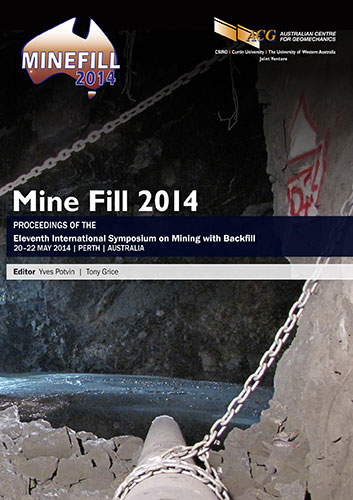Filling of voids in coal longwall mining with caving – technical, environmental and safety aspects

|
Authors: Palarski, J; Plewa, F; Strozik, G Paper is not available for download Contact Us |
DOI https://doi.org/10.36487/ACG_rep/1404_39_Strozik
Cite As:
Palarski, J, Plewa, F & Strozik, G 2014, 'Filling of voids in coal longwall mining with caving – technical, environmental and safety aspects', in Y Potvin & T Grice (eds), Mine Fill 2014: Proceedings of the Eleventh International Symposium on Mining with Backfill, Australian Centre for Geomechanics, Perth, pp. 483-491, https://doi.org/10.36487/ACG_rep/1404_39_Strozik
Abstract:
In the majority of mining operations in the Upper Silesia Coal Basin, the longwall mining method with caving is being used. Control of the roof by caving has numerous technical advantages and does not generate additional costs which, in case of traditional hydraulic backfill, can easily make mining operations unprofitable. However, the presence of caving zones generates many problems related to the stability of the rock mass and mine subsidence, water and gas permeability, spontaneous coal ignition, methane hazard etc., which generally are considered environmental and safety issues. It is important that filling of voids in cavings (grouting) does not interfere with mining production and does not involve significant additional costs. An important part of the paper is dedicated to the assessment of the receptivity of cavings. Results of measurements of volumes of fill mixture placed in cavings of 65 Polish coal mines are presented and discussed. Due to the lack of direct observations of caving filling results, a statistical assessment method was adopted, considering the highest ration of measured fill volumes to extraction volumes as the receptivity. The application of this technology may be considered in environment protection terms, like the utilisation of waste and saline waters, the improved stability of the rock mass, the reduction of gas and groundwaters migration into the rock mass, etc. Technologies of filling of voids in cavings adopted in the Polish coal mining industry are also presented in the paper, from current problems and a further development point of view. Physical properties and requirements for fill materials and mixtures are discussed. Limitations and issues with the application of this technology, which occur in mining practices, are also presented and discussed.
References:
Jendruś, R, Lutyński, M, Pierzyna P & Strozik, G 2008, ‘Flow and fill properties of fly ash – water slurries for grouting of cavings in underground longwall mining’, Proceedings of the 14th International Conference on Transport And Sedimentation Of Solid Particles, Saint Petersburg Mining Institute, Saint Petersburg, pp. 232-40.
Palarski, J 2004 ‘Selection of a fill system for longwall in coal mines’, Proceedings of the 8th International Symposium on Mining with Backfill, Mining Research and Development, Changsha, pp. 82-96.
Palarski, J 2007 ‘Design of backfill and grouting systems used as support in Polish mines’, in FP Hassani & JF Archibald (eds), Proceedings of the 9th International Symposium on Mining with Backfill, Canadian Institute of Mining, Metallurgy and Petroleum, Westmount, on CD-ROM.
Palarski, J, Pierzyna, P & Strozik, G 2008, ‘Application of coal combustion by-products in technologies of underground mining’, Proceedings of the International Conference EuroCoalAsh, Ekotech, pp. 315-29.
Palarski, J, Plewa, F & Strozik, G 2011, ‘Backfill and grouting technology in underground coal mining using saline mine water’, Proceedings of the 10th International Symposium on Mining with Backfill, in HJ Ilgner (ed.), The Southern African Institute of Mining and Metallurgy, Johannesburg, pp. 15-9.
Plewa, F & Mysłek, Z 2001, Zagospodarowanie Odpadów Przemysłowych w Podziemnych Technologiach Górniczych, Silesian University of Technology, Gliwice, Upper Silesia, in Polish.
Plewa, F, Mysłek, Z & Strozik, G 2008, ‘Ocena parametrów doszczelniania zrobów zawałowych odpadami drobnoziarnistymi w kopalniach węgla kamiennego’, V Warsztaty Utex, Fly Ash In Coal Mining, Utex, Rybnik, pp. 7-18, in Polish.
Polish Committee for Standardization 1998, PN-G/11011:1998: Materials for stabilised backfill and grouting of cavings – requirements and test procedures, Polish Committee for Standardization, Warsaw.
Singh, B & Goel, RK 1999, Rock Mass Classification – A Practical Approach in Civil Engineering, Elsevier Science Ltd, Kidlington, Oxforshire.
Strozik, G 2010 ‘Ocena własności transportowych i migracyjnych mieszanin drobnofrakcyjnych do doszczelniania zrobów zawałowych w aspekcie ich własności reologicznych’, Cuprum Ore Mining Scientific and Technical Magazine, vol. 2 (55), Wrocław, pp. 95-109, in Polish.
Whittaker, BN & Reddish, DJ 1989, Subsidence – Occurrence, Prediction and Control, Elsevier Science Ltd, Kidlington, Oxforshire.
© Copyright 2025, Australian Centre for Geomechanics (ACG), The University of Western Australia. All rights reserved.
View copyright/legal information
Please direct any queries or error reports to repository-acg@uwa.edu.au
View copyright/legal information
Please direct any queries or error reports to repository-acg@uwa.edu.au